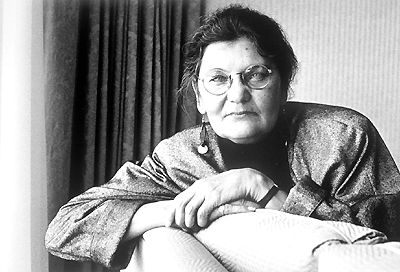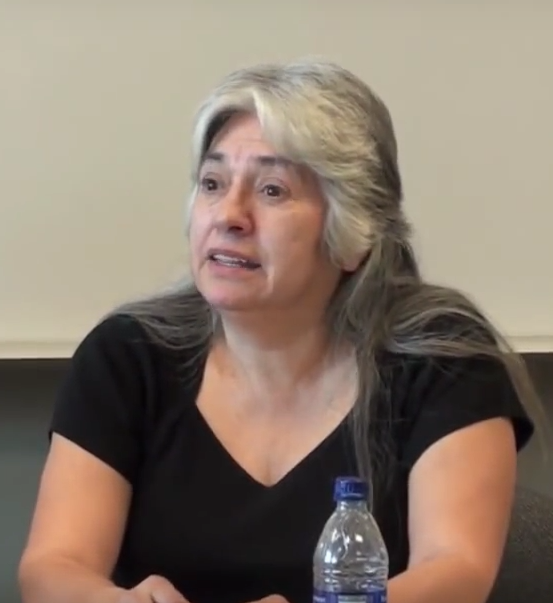
In honour of International Women’s Day, female activists march to draw attention to missing and murdered Indigenous women and girls in Canada (8 March 2013, Montreal, Quebec).
(courtesy blogocram/Flickr CC BY-NC 2.0)
Core Ideas
Indigenous feminisms can be understood as an ideology or concept, an identity and an expression. There is no single expression of Indigenous feminism and therefore, the term is often referred to as Indigenous feminisms (plural). Generally speaking, Indigenous feminisms address the many ways that sexuality, gender and gender norms (expectations about how people should act or behave based on perceptions about their gender) shape Indigenous people’s lives.
Although gender, sex and sexuality are central in Indigenous feminisms, they intersect with other aspects of people’s identities, including indigeneity (i.e., Indigenous identity), age, ability and social class. Scholars therefore emphasize that Indigenous feminisms should consider multiple aspects of identity. To focus on only one or two creates incomplete and flawed understandings.
Indigenous feminisms are also concerned with the ways that gender is embedded in broader power relations, and with the ways that sexism, racism and colonialism are structures of oppression that operate together. Scholars Maile Arvin (of Kanaka Maoli ancestry), Eve Tuck (Unangax) and Angie Morrill (Klamath) (in addition to many other Indigenous feminists) have argued that “settler colonialism has been and continues to be a gendered process.” That is, the impacts of settler colonialism are targeted and experienced differently depending on one’s gender. It is well-documented, for instance, that Indigenous women on average experience higher rates of gender-based violence, have lower incomes and have less political representation compared to Indigenous men and non-Indigenous women. Too often these realities are ignored by settler communities and can even be disregarded within some Indigenous communities as well.
Indigenous feminisms challenge people to acknowledge, understand and address these oppressions. As Kim TallBear (Sisseton Wahpeton Oyate) explains, Indigenous feminisms bring marginalized voices together to dismantle hierarchies and “be in good relation” with one another. Therefore, Indigenous sovereignty, frameworks and ways of knowing are all central to Indigenous feminisms. Additionally important are the realities and impacts of heteropatriarchy and settler colonialism, gendered experiences and agency, and ethical relationships to one another and to the lands that we live on.
However, Indigenous feminisms should not be understood only as a response to the imposition of patriarchal settler gender norms onto Indigenous societies (e.g., through the Indian Act and through residential schools). Rather, Indigenous feminisms work to support well-being and positive gender relations in Indigenous communities as well.
Approaches and Expressions
With such varied definitions and meanings, it is not surprising that there are diverse yet interrelated approaches to Indigenous feminisms. Since the late 19th century, Indigenous women such as Pauline Johnson (Mohawk), Beth Brant (Mohawk), Maria Campbell (Métis) and Louise Bernice Halfe (Cree) have used poetry, music, literature and performance to emphasize the resilience and empowerment of Indigenous women, and are widely considered important (though not always intentional) contributors to Indigenous feminisms.
Though increasingly common in community and academic conversations, Indigenous feminisms are by no means new. However, the concept of Indigenous feminism gained currency around the late 1990s after celebrated author and critic Lee Maracle (Stó:lō) spoke about the place of Indigenous women in broader Canadian women’s movements. She explained, “I am not interested in gaining entry to the doors of the ‘white women’s movement.’ I would look just a little ridiculous sitting in their living rooms saying ‘we this and we that.’” As Mishuana Goeman (Seneca) and Jennifer Nez Denetdale (Diné) have pointed out, “Feminism [itself] is long held to be in purview of white rule.… It is long believed to be a European invention or, much worse, a colonial imposition that sought to destroy tribal ways of life.” Maracle and others therefore sought to shift away from “white feminisms” and embrace principles that aligned with Indigenous realities.
Since the late 2000s, there have been two principal trends within Indigenous feminist scholarship: works that approach Indigenous feminism as a theoretical concept and identity; and those that apply Indigenous feminisms as a category of analysis across a number of fields and topics.
Many scholars in the former category grapple with the complex relationship between Indigenous women and feminism. Their works reflect on feminist ideals and practices, as well as expressions of feminisms in art and culture, law, politics, activism and everyday life. Transnational conversations about Indigenous feminisms highlight shared struggles as well as discrepancies in how Indigenous women across the globe see themselves and feminist ideologies. Perhaps most importantly, these works offer definitions of Indigenous feminisms that others can adopt, critique and contribute to on their own terms.
Alongside (and at times even within) these works are approaches to Indigenous feminisms that expand feminist theory into new areas of analysis. For example, Indigenous feminisms inform academic and community conversations on violence against Indigenous women, sovereignty and LGBTQ2 issues. Exploring these subjects allows for deeper understandings of Indigenous feminisms that are not solely concerned with normative genders and sexualities.
Application
Indigenous feminisms raise critical questions about gender in relation to politics, law, history, economics, art, culture, health and social relationships. Indigenous feminisms are vital in challenging racist, sexist and colonial oppression and collectives have emerged from these discussions, shaping movements such as Idle No More and grassroots organizations like the Native Youth Sexual Health Network. Indigenous feminist perspectives are also central in discussions about contemporary socio-political issues, such as missing and murdered Indigenous women and girls (MMIWG), as they raise key concerns not only about this violence, but also about the roles that various people and communities have in responding to this problem. Additionally, they challenge the lack of prior government engagement in MMIWG cases. While varied experiences and identities affect views about and uses of Indigenous feminism, they remain useful frameworks of understanding for all people.

 Share on Facebook
Share on Facebook Share on X
Share on X Share by Email
Share by Email Share on Google Classroom
Share on Google Classroom




